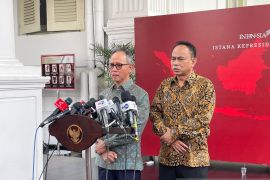According to Chief Economic Minister Darmin Nasution, the effectiveness of the government`s policy in boosting exports and reducing imports to narrow the deficit of the current account could be seen in the fourth quarter.
The relatively high economic growth which reached 5.17 percent in the third quarter of 2018 had triggered increase in the demand for imported goods and widened the current account deficit.
The current account deficit in the third quarter of 2018 was recorded at 8.8 billion, or about 3.37 percent of GDP. This was higher than the CAD in the second quarter which was only $8.0 billion or 3.02 percent of the GDP.
Finance Minister Sri Mulyani Indrawati said that one of the causes of the high current account deficit in quarter III of 2018 was the increasing demand for imported goods. Import value in the period was recorded at US$49.72 billion.
"On the one hand we are pleased that our economic growth is relatively high at 5.17 percent, but consequently the demand for imported goods has also increased," Sri Mulyani said in Jakarta on Friday (Nov.9)
The Minister stressed that the government will continue to monitor and review the current account deficit movement to remain under control and under 3 percent of GDP.
However, the former World Bank Managing Director did not want to estimate the achievement of the current account balance deficit at the end of the year.
"In this case we are looking for a balance of caution. Therefore, every month we will review the statistics, how the demand for imported goods, both imported oil and non-oil and gas," she said.
Earlier, the Indonesian central bank (Bank Indonesia/BI) recorded that third quarter current account deficit rose to US$8.8 billion or 3.37 percent of the GDP due to rising oil imports that weakened the performance of oil and gas trade balance.
"The rising deficit in oil and gas trade balance resulted from increasing oil imports amid global crude price hike," Bank Indonesia said on Friday.
The current account reflects the inflow and outflow of foreign exchange earnings in a country and that this parameter also serves as a reference for investors to invest in the country and determine the movement of the currency`s exchange rate
Cumulatively, the current account deficit until the third quarter of 2018 reached 2.86 percent of the GDP which according to the central bank is still safe.
According to the central bank, the rising current account deficit in the third quarter of 2018 resulted from the weakening performance of goods trade balance and the rising deficit of service balance. In the second quarter of 2018 the current account deficit reached US$8.0 billion or 3.02 percent of the GDP.
The goods trade balance covers the oil and gas sector and the non-oil/non-gas sector. The deficit of oil and gas trade balance increased, while the increase in non-oil/non-gas trade balance is relatively limited due to high imports.
High demand for imported goods in the non-oil/non-gas sector was also the result of rising domestic consumption. The rising deficit of oil and gas trade balance resulted from increasing oil imports amid increasing global crude prices.
However, according Minister Darmin Nasution, the government would like to see the effectiveness of its measures in boosting exports and reducing import in the fourth quarter of the year.
"We believe in a number of policies that they will have effective impact," Nasution said in Jakarta on Friday. The various policies aim to encourage the performance of investment in export-based processing and import substitution and the utilization of biodiesel (B20) to reduce diesel imports. This had not yet been fully recorded in the current account balance deficit in quarter III of 2018.
Nasution believes the policy will show results at the end of the year, so that the realization of the current account deficit in quarter IV can be lower than quarter III of 2018 which was recorded at 8.8 billion US dollars or 3.37 percent of GDP.
"The percentage of the current account deficit to GDP in the fourth quarter should record a decline. About the figure of its decline? I can`t say it frankly. Usually, the percentage in the fourth quarter is not more than the previous quarter," he said.
Nasution explained, overcoming the problem of current transactions is not an easy problem. For the past 40 years, Indonesia has recorded more deficit accounts than surplus ones because many raw materials, half-finished products and capital must be imported.
However, the current account now is not expected to experience a deficit too deep that would raise a serious problem because the government and the central bank can still manage the capital and financial account to record surpluses and contribute to the economy.
"So it depends on capital and financial transactions because over a number of years, the capital and financial account surplus has always cover the balance," he said.
Editing by Yoseph Hariyadi
Reporter: Andi Abdussalam
Editor: Heru Purwanto
Copyright © ANTARA 2018












